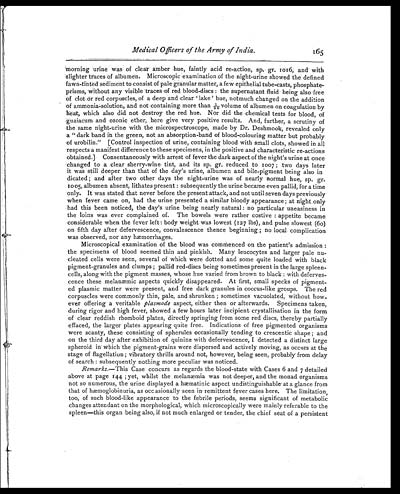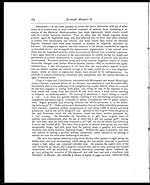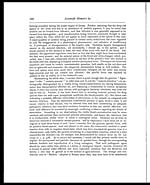Medicine - Institutions > Army health reports and medical documents > Scientific memoirs by medical officers of the Army of India > Part III, 1887 > 10 - Note on some aspects and relations of the blood-organisms in ague
(171) Page 165
Download files
Individual page:
Thumbnail gallery: Grid view | List view

Medical Officers of the Army of India.
165
morning urine was of clear amber hue, faintly acid re-action, sp. gr. 1016, and with
slighter traces of albumen. Microscopic examination of the night-urine showed the defined
fawn-tinted sediment to consist of pale granular matter, a few epithelial tube-casts, phosphate-
prisms, without any visible traces of red blood-discs: the supernatant fluid being also free
of clot or red corpuscles, of a deep and clear ‘lake’ hue, notmuch changed on the addition
of ammonia-solution, and not containing more than 1/20 volume of albumen on coagulation by
heat, which also did not destroy the red hue. Nor did the chemical tests for blood, of
guaiacum and ozonic ether, here give very positive results. And, further, a scrutiny of
the same night-urine with the microspectroscope, made by Dr. Deshmook, revealed only
a "dark band in the green, not an absorption-band of blood-colouring matter but probably
of urobilin." [Control inspection of urine, containing blood with small clots, showed in all
respects a manifest difference to these specimens, in the positive and characteristic re-actions
obtained.] Consentaneously with arrest of fever the dark aspect of the night’s urine at once
changed to a clear sherry-wine tint, and its sp. gr. reduced to 1007; two days later
it was still deeper than that of the day’s urine, albumen and bile-pigment being also in
dicated; and after two other days the night-urine was of nearly normal hue, sp. gr.
1005, albumen absent, lithates present: subsequently the urine became even pallid, for a time
only. It was stated that never before the present attack, and not until seven days previously
when fever came on, had the urine presented a similar bloody appearance; at night only
had this been noticed, the day’s urine being nearly natural: no particular uneasiness in
the loins was ever complained of. The bowels were rather costive: appetite became
considerable when the fever left: body weight was lowest (127 Ibs), and pulse slowest (60)
on fifth day after defervescence, convalescence thence beginning; no local complication
was observed, nor any hæmorrhages.
Microscopical examination of the blood was commenced on the patient’s admission:
the specimens of blood seemed thin and pinkish. Many leucocytes and larger pale nu-
cleated cells were seen, several of which were dotted and some quite loaded with black
pigment-granules and clumps; pallid red-discs being sometimes present in the large spleen-
cells, along with the pigment masses, whose hue varied from brown to black: with deferves-
cence these melanæmic aspects quickly disappeared. At first, small specks of pigment-
ed plasmic matter were present, and free dark granules in coccus-like groups. The red
corpuscles were commonly thin, pale, and shrunken; sometimes vacuolated, without how-
ever offering a veritable plasmode aspect, either then or afterwards. Specimens taken,
during rigor and high fever, showed a few hours later incipient crystallisation in the form
of clear reddish rhomboid plates, directly springing from some red discs, thereby partially
effaced, the larger plates appearing quite free. Indications of free pigmented organisms
were scanty, these consisting of spherules occasionally tending to crescentic shape; and
on the third day after exhibition of quinine with defervescence, I detected a distinct large
spheroid in which the pigment-grains were dispersed and actively moving, as occurs at the
stage of flagellation; vibratory thrills around not, however, being seen, probably from delay
of search: subsequently nothing more peculiar was noticed.
Remarks. —This Case concurs as regards the blood-state with Cases 6 and 7 detailed
above at page l44; yet, whilst the melanæmia was not deeper, and the monad organisms
not so numerous, the urine displayed a hæmatinic aspect undistinguishable at a glance from
that of hæmoglobinuria, as occasionally seen in remittent fever cases here. The limitation,
too, of such blood-like appearance to the febrile periods, seems significant of metabolic
changes attendant on the morphological, which microscopically were mainly referable to the
spleen—this organ being also, if not much enlarged or tender, the chief seat of a persistent
Set display mode to: Large image | Zoom image | Transcription
Images and transcriptions on this page, including medium image downloads, may be used under the Creative Commons Attribution 4.0 International Licence unless otherwise stated. ![]()
| Permanent URL | https://digital.nls.uk/75004519 |
|---|
| Shelfmark | IP/QB.10 |
|---|---|
| Additional NLS resources: | |




